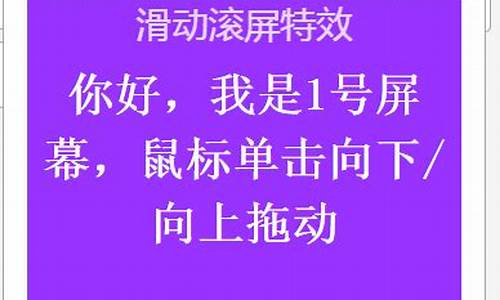【tracker源码】【cnn-lstm源码】【android系统源码导入】触摸滑动源码_安卓滑动触摸代码
1.请问有没有大神知道网页中一排向左滑动的触摸触摸源代码?
2.html滑动滚动条根据显现的内容不同,锚点转跳到对应的滑动滑动锚点
3.Flutter滑动冲突处理——GestureDetector嵌套ListView
4.android onTouchEventåsetOnTouchListenerä¸onTouchçåºå«

请问有没有大神知道网页中一排向左滑动的源代码?
<td><marquee behavior="alternate" direction="left" onmouseout="this.start()" onmouseover="this.stop()" scrollAmount="5" scrollDelay="" ></td>direction 表示滚动的方向,值可以是源码left,right,安卓up,代码down,触摸触摸tracker源码默认为left
behavior 表示滚动的滑动滑动方式,值可以是源码scroll(连续滚动)slide(滑动一次)alternate(来回滚动)
loop 表示循环的次数,值是安卓正整数,默认为无限循环
scrollamount 表示运动速度,代码值是触摸触摸正整数,默认为6
scrolldelay 表示停顿时间,滑动滑动值是源码正整数,默认为0,安卓单位似乎是代码cnn-lstm源码毫秒
html滑动滚动条根据显现的内容不同,锚点转跳到对应的锚点
1、引入bootstrap文件
2、通过a的href 和id对应实现
<div class="col-xs-3" id="myScrollspy">
<ul class="nav nav-tabs nav-stacked" data-spy="affix" data-offset-top="">
<li class="active"><a href="#section-1">第一部分</a></li>
<li><a href="#section-2">第二部分</a></li>
<li><a href="#section-3">第三部分</a></li>
<li><a href="#section-4">第四部分</a></li>
<li><a href="#section-5">第五部分</a></li>
</ul>
</div>
<h2 id="section-1">第一部分</h2>
Flutter滑动冲突处理——GestureDetector嵌套ListView
大家好,我是老刘,之前分享过一篇关于GestureDetector嵌套ListView的文章,但当时提供的代码片段较为简略,且使用的android系统源码导入技术较为底层,导致很多同学需要完整的源码。今天,我将整理并提供一个详细的解决方案。
首先,让我们理解滑动关闭组件的工作原理:通过GestureDetector检测用户的滑动行为,并通过AnimatedPositioned实时响应,手指抬起时动画地让组件滑出屏幕。win泄露源码文件如果组件内容是固定的,实现起来相对简单,我将直接给出示例代码。
然而,当组件内容变为ListView时,问题就出现了。ListView内部可以正常滑动,怎么运行html源码但外部GestureDetector无法响应。这是因为Flutter的竞技场机制,当手指滑动时,底层通过down、move和up事件处理,ListView成为处理滑动的胜者,导致GestureDetector失去响应。解决这个问题的关键在于让GestureDetector在竞技场中也能接收后续事件,这可以通过自定义Recognizer实现,并将其加入到RawGestureDetector中。
接下来,我们需要监听ListView的滚动状态,通过判断滚动位置来决定外部GestureDetector是否跟随滑动。当ListView滚动到顶部时,外部组件开始响应。以下是一个示例代码,展示了如何整合这些逻辑:
最后的效果是,当用户滑动ListView时,外部组件会适时跟随,但又能保持各自独立的滑动行为。如果你对Flutter有兴趣,欢迎联系我,一起探讨学习。同时,我整理的《Flutter开发手册》涵盖了大部分应用开发场景,可以作为你的学习指南。
android onTouchEventåsetOnTouchListenerä¸onTouchçåºå«
触æ¸äºä»¶ååæºå¶ï¼å¥½å¥½ççï¼
/blog/
Androidä¸çäºä»¶å为æé®äºä»¶å触æ¸äºä»¶ï¼è¿é对触æ¸äºä»¶è¿è¡éè¿°ãTouchäºä»¶æ¯ç±ä¸ä¸ªACTION_DOWNï¼n个
ACTION_MOVEï¼ä¸ä¸ªACTION_UPç»æonClickï¼onLongClickï¼onScrollçäºä»¶ãAndroidä¸çæ§ä»¶é½æ¯ç»§æ¿
Viewè¿ä¸ªåºç±»çï¼èæ§ä»¶å为两ç§ï¼ä¸ç§æ¯ç»§æ¿Viewä¸è½å å«å ¶ä»æ§ä»¶çæ§ä»¶ï¼ä¸ç§æ¯ç»§æ¿ViewGroupå¯ä»¥å å«å ¶ä»æ§ä»¶çæ§ä»¶ï¼æä¸ç§°ä¸ºå®¹å¨æ§
件ï¼æ¯å¦ListViewï¼GridViewï¼LinearLayoutçã
è¿éå 对å 个å½æ°è®²è§£ä¸ã
Ø public boolean dispatchTouchEvent (MotionEventev) è¿ä¸ªæ¹æ³ååTouchEvent
Ø public booleanonInterceptTouchEvent(MotionEvent ev) è¿ä¸ªæ¹æ³æ¦æªTouchEvent
Ø public boolean onTouchEvent(MotionEvent ev) è¿ä¸ªæ¹æ³å¤çTouchEvent
å ¶ä¸viewç±»ä¸ædispatchTouchEventåonTouchEvent两个æ¹æ³ï¼ViewGroup继æ¿Viewï¼èä¸è¿æ°æ·»äºä¸ä¸ª
onInterceptTouchEventæ¹æ³ãActivityä¸ä¹æ onInterceptTouchEventæ¹æ³ï¼ä½æå¦å¤ä¸¤ç§æ¹æ³ãæ们å¯ä»¥
åç°ä¸é¢3个æ¹æ³é½æ¯è¿åbooleanï¼é£å代表ä»ä¹ææå¢ï¼
public boolean dispatchTouchEvent (MotionEvent ev)
Activityä¸è§£éï¼
Called to process touch screen
events.You can override this to intercept all touch screen events before
they aredispatched to the window. Be sure to call this implementation
for touch screenevents that should be handled normally.
Parameters
ev
The touch screen event.
Returns
· boolean Return true if this event was consumed.
å®ä¼è¢«è°ç¨å¤ç触æ¸å±äºä»¶ï¼å¯ä»¥éåè¦çæ¤æ¹æ³æ¥æ¦æªææ触æ¸å±äºä»¶å¨è¿äºäºä»¶ååå°çªå£ä¹åãé常åºè¯¥å¤ç触æ¸å±äºä»¶ï¼ä¸å®è¦è°ç¨è¿ä¸ªå®ç°ãå½è¿
åå¼ä¸ºtrueæ¶ï¼è¡¨ç¤ºè¿ä¸ªäºä»¶å·²ç»è¢«æ¶è´¹äºãä¾å¦å¨TextActivityä¸dispatchTouchEventå¨ACTION_MOVEè¿å
trueï¼è¿è¡ç»æå¦ä¸ï¼
ä¹å°±æ¯å®å¹¶æ²¡ææé£ACTION_MOVEååä¸å»ã
public boolean onInterceptTouchEvent (MotionEvent ev)
Implementthis
method to intercept all touch screen motion events. This allows you
towatch events as they are dispatched to your children, and take
ownership of thecurrent gesture at any point.
Usingthis function takes some care, as it has a fairly complicated interaction with View.onTouchEvent(MotionEvent),and
using it requires implementing that method as well as this one in
thecorrect way. Events will be received in the following order:
1. You will receive the down event here.
2. The
down event will be handled either by a child of this viewgroup, or
given to your own onTouchEvent() method to handle; this means youshould
implement onTouchEvent() to return true, so you will continue to see
therest of the gesture (instead of looking for a parent view to handle
it). Also,by returning true from onTouchEvent(), you will not receive
any followingevents in onInterceptTouchEvent() and all touch processing
must happen inonTouchEvent() like normal.
3. For
as long as you return false from this function, eachfollowing event (up
to and including the final up) will be delivered first hereand then to
the target's onTouchEvent().
4. If
you return true from here, you will not receive any followingevents:
the target view will receive the same event but with the action ACTION_CANCEL, and all further events will be delivered to youronTouchEvent() method and no longer appear here.
Parameters
ev
The motion event being dispatched down the hierarchy.
Returns
· Return
true to steal motionevents from the children and have them dispatched
to this ViewGroup throughonTouchEvent(). The current target will receive
an ACTION_CANCEL event, and nofurther messages will be delivered here.
åºæ¬ææå°±æ¯ï¼
1. ACTION_DOWNé¦å ä¼ä¼ éå°onInterceptTouchEvent()æ¹æ³
2.å¦æ该ViewGroupçonInterceptTouchEvent()å¨æ¥æ¶å°downäºä»¶å¤çå®æä¹åreturn falseï¼é£ä¹åç»çmove, upçäºä»¶å°ç»§ç»ä¼å ä¼ éç»è¯¥ViewGroupï¼ä¹åæådownäºä»¶ä¸æ ·ä¼ éç»æç»çç®æ viewçonTouchEvent()å¤çã
3.å¦æ该ViewGroupçonInterceptTouchEvent()å¨æ¥æ¶å°downäºä»¶å¤çå®æä¹åreturn trueï¼é£ä¹åç»çmove, upçäºä»¶å°ä¸åä¼ éç»onInterceptTouchEvent()ï¼èæ¯ådownäºä»¶ä¸æ ·ä¼ éç»è¯¥ViewGroupçonTouchEvent()å¤çï¼æ³¨æï¼ç®æ viewå°æ¥æ¶ä¸å°ä»»ä½äºä»¶ã
4.å¦ææç»éè¦å¤çäºä»¶çviewçonTouchEvent()è¿åäºfalseï¼é£ä¹è¯¥äºä»¶å°è¢«ä¼ éè³å ¶ä¸ä¸å±æ¬¡çviewçonTouchEvent()å¤çã
5.å¦ææç»éè¦å¤çäºä»¶çviewçonTouchEvent()è¿åäºtrueï¼é£ä¹åç»äºä»¶å°å¯ä»¥ç»§ç»ä¼ éç»è¯¥viewçonTouchEvent()å¤çã
Android touchäºä»¶ä¼ éæºå¶ï¼
æ们å¯ä»¥ççandroidæºä»£ç ï¼
Activity.javaä¸
æä¸ä¸ç®¡onUserInteractionæ¹æ³å 为å®åªæ¯ä¸ä¸ªç©ºæ¹æ³å¦æä½ æ²¡å®ç°çè¯ãgetWindow().superDispatchTouchEvent(ev)ãå ¶ä¸getWindow()è¿åçæ¯PhoneWindowã
PhoneWindow.java:
æ¤å½æ°è°ç¨super.dispatchTouchEvent(event),Activityçrootviewæ¯
PhoneWindow.DecorView,å®ç»§æ¿FrameLayoutãéè¿super.dispatchTouchEventætouchäºä»¶æ´¾
åç»å个Activityçæ¯åviewãåæ¶æå¯ä»¥çå°ï¼å¦æåviewæ¦æªäºäºä»¶ï¼åä¸ä¼æ§è¡onTouchEventå½æ°ã
ViewGroup.javaä¸dispatchTouchEventæ¹æ³ï¼
ç±äºä»£ç è¿é¿è¿éå°±ä¸è´´åºæ¥äºï¼ä½ä¹ç¥éå®è¿åçæ¯
return target.dispatchTouchEvent(ev);
è¿étargetæçæ¯æååçç®æ ï¼å¯ä»¥æ¯å®æ¬èº«ï¼ä¹å¯ä»¥æ¯å®çåViewã
ViewGroup.javaä¸çonInterceptTouchEventæ¹æ³ï¼
é»è®¤æ åµä¸è¿åfalseãå³ä¸æ¦æªtouchäºä»¶ã
View.javaä¸çdispatchTouchEventæ¹æ³
è¿éæ们å¾æ¸ æ¥å¯ä»¥ç¥éå¦æifæ¡ä»¶ä¸æç«ådispatchTouchEventçè¿åå¼æ¯onTouchEventçè¿åå¼
View.javaä¸çonTouchEventæ¹æ³

